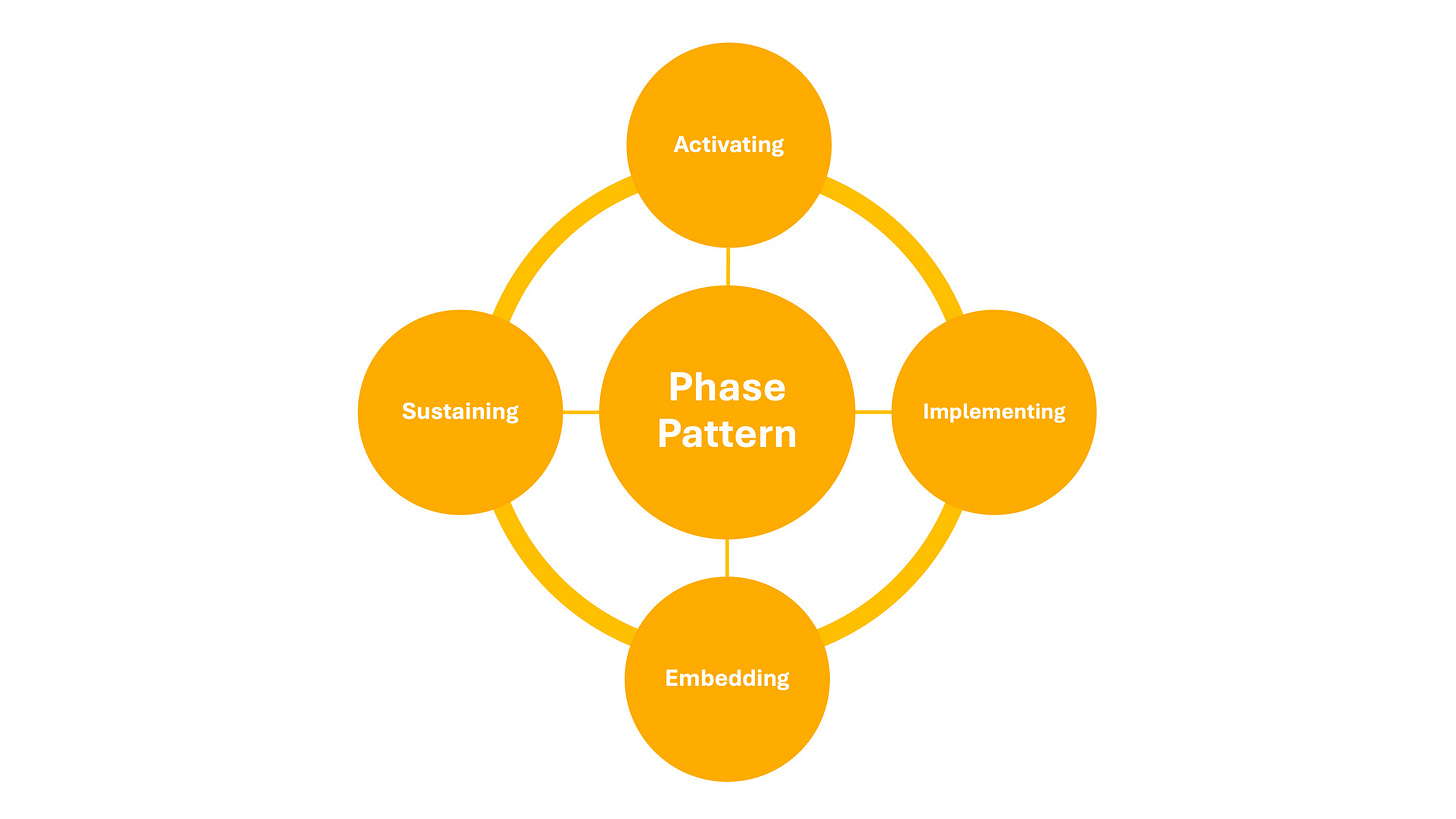Phase Pattern
Sustaining a sustainability transformation through embedding culture by design
Whether in a Petri dish or the global economy, things happen because culture is the fundamental medium. Organizations, communities and societies are realizing that ideas and efforts grow, contend and thrive only when nurtured by the culture.
Dave Snowden1
Challenge: How might you design a purposeful transformation with a sustaining culture?
Cluster: Transforming Practice Patterns
Type: Essential Practice Pattern with multiple Nested Patterns
Purpose
The Phase Pattern enables social entities to activate a sustainability transformation through multiple phases of strategic design, mindful of adaptive behaviour and emergent phenomena in the practice context, while growing a supporting culture of sustainability.
Pattern Description
The Phase Pattern is at the heart of the transformation process, enabling sustainability practitioners to apply holistic complexity thinking, accommodating adaptation, self-organization and emergence in the course of change. The Phase Pattern thus addresses the limitations of the linear and mechanistic business-as-usual approach to change.
The Phase Pattern has four Elemental Patterns: Activating, Implementing, Embedding and Sustaining and is the only time-based pattern in the Practice Pattern Ecosystem, insofar as a transformation process follows the “arrow of time”.
Further, four Patterns from the Transforming Patterns and Enriching Patterns Clusters act as Nested Patterns within the Phase Pattern as the core principle for transformation: the Design Cycles Pattern with its own nested Enabling, Guiding and Conviviality Patterns.
By making the Phases explicit, and each with a Design Cycle spiralling through each phase, the possibility of achieving the transformation improve greatly. Design is a continuous cycle – even the way of embedding a change in the culture of a social entity is a complex ongoing strategic design challenge!
The key attitude is for practitioners and participants to remain adaptable and responsive to emergent changes in the practice context, with design outcomes regarded as “working” designs - as a “permanently beta” state.
Elemental Patterns
Activating: The Activating Pattern is the starting point in the transformation process. It is focused on the design of the transformation and because possibilities are many, it is the most intensive Phase, requiring considerable mapping, discovery, experimentation and sensemaking activities. The Activating Phase is guided by the Pathways Pattern and the strategic drivers of the change. Whatever the driver, get started on the sustainability transformation wherever you are!
Implementing: The Implementing Phase is where the transformation design is rolled out to the social entity. By the end of the Implementing Phase, the transformation design, including the Implementing Phase design, should permeate the social entity to the operational process level, ready for the Embedding Phase. The Implementing Phase cycles through the Design Cycles Pattern, but with different emphases, and finer graining, focusing on detailed design of operational processes in alignment with the vision.
Embedding: The Embedding Phase is where the transformation process has clearly been adopted and the visions adapted across the social entity as appropriate to the operational scope; people’s capability; and the scale of activity. Amplification, dampening and pulsing actions become a priority, arising from ongoing learning and sensemaking, as well as on-going safe-fail experiments to determine if developments and adaptations are remaining within the transformation trajectory.
Sustaining: Over time, emergent qualities of the re-designed social entity system present as new opportunities to refresh the system and to keep it healthy, responsive and adaptive. Complacency, on the other hand, can emerge from a successful activation and implementation. Implemented actions can lose their beneficial impact through emergent qualities of the new system design as well. If new desired behaviours are not supported, and the sustainability culture is not strong enough, the system can revert to business-as-usual and rigid processes can emerge which stifle on-going adaptation and restrict system resilience.
Atlas Navigation
Go to the Elemental Patterns within the Phase Pattern:
Activating Implementing Embedding Sustaining
Go to the Pathways Pattern within the Transforming Patterns Cluster
Go to the Design Cycles Pattern within the Transforming Patterns Cluster
Version
Version 1.0 - 2 Jun 2024
Version 1.2 - 23 May 2025
Version 1.2.1 - 15 July 2025
Version 1.2.2 - 31 July 2025
Snowden, D. (2003). The Paradox of Culture. Cardiff: The Cynefin Centre for Organizational Complexity.


